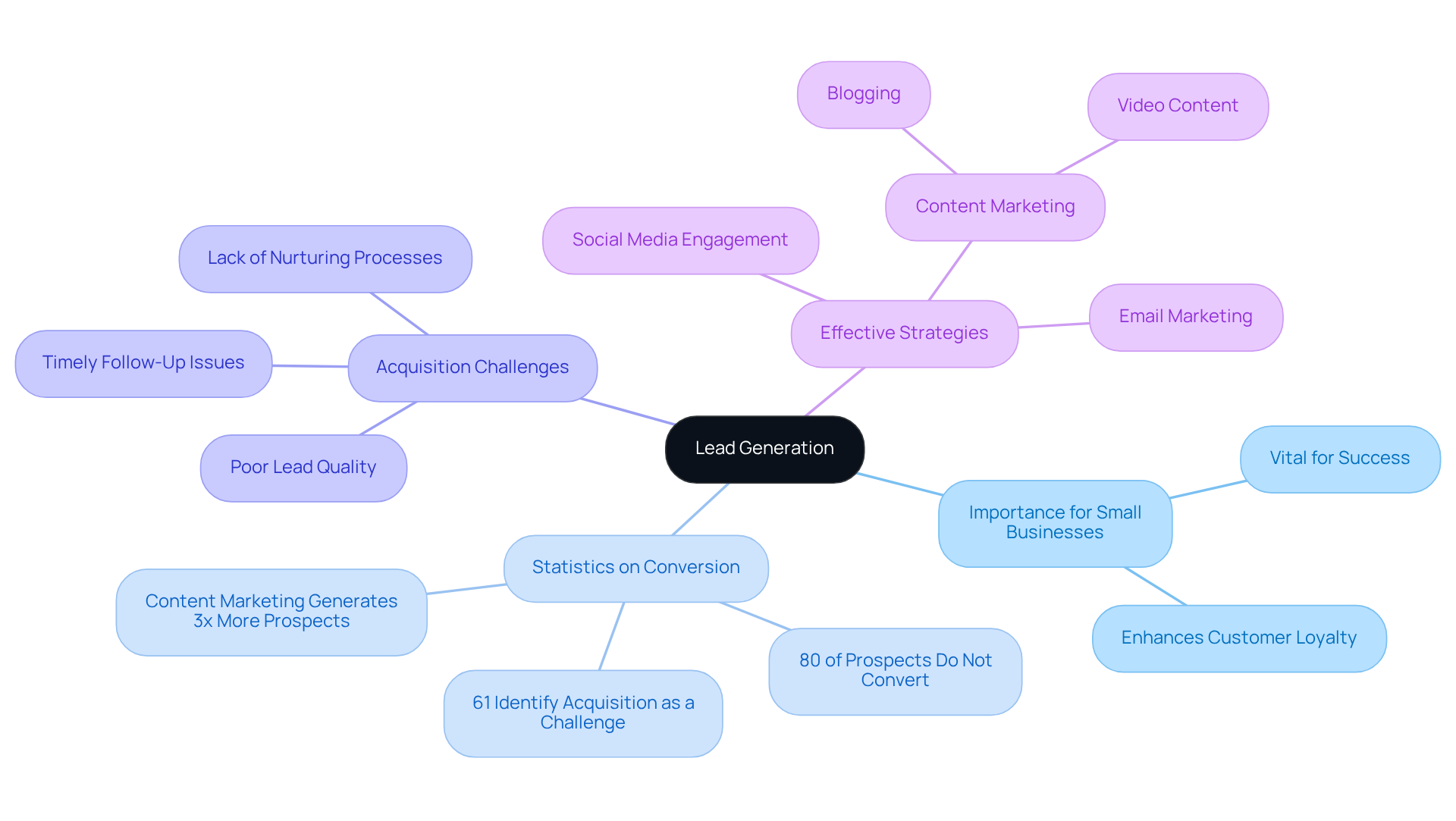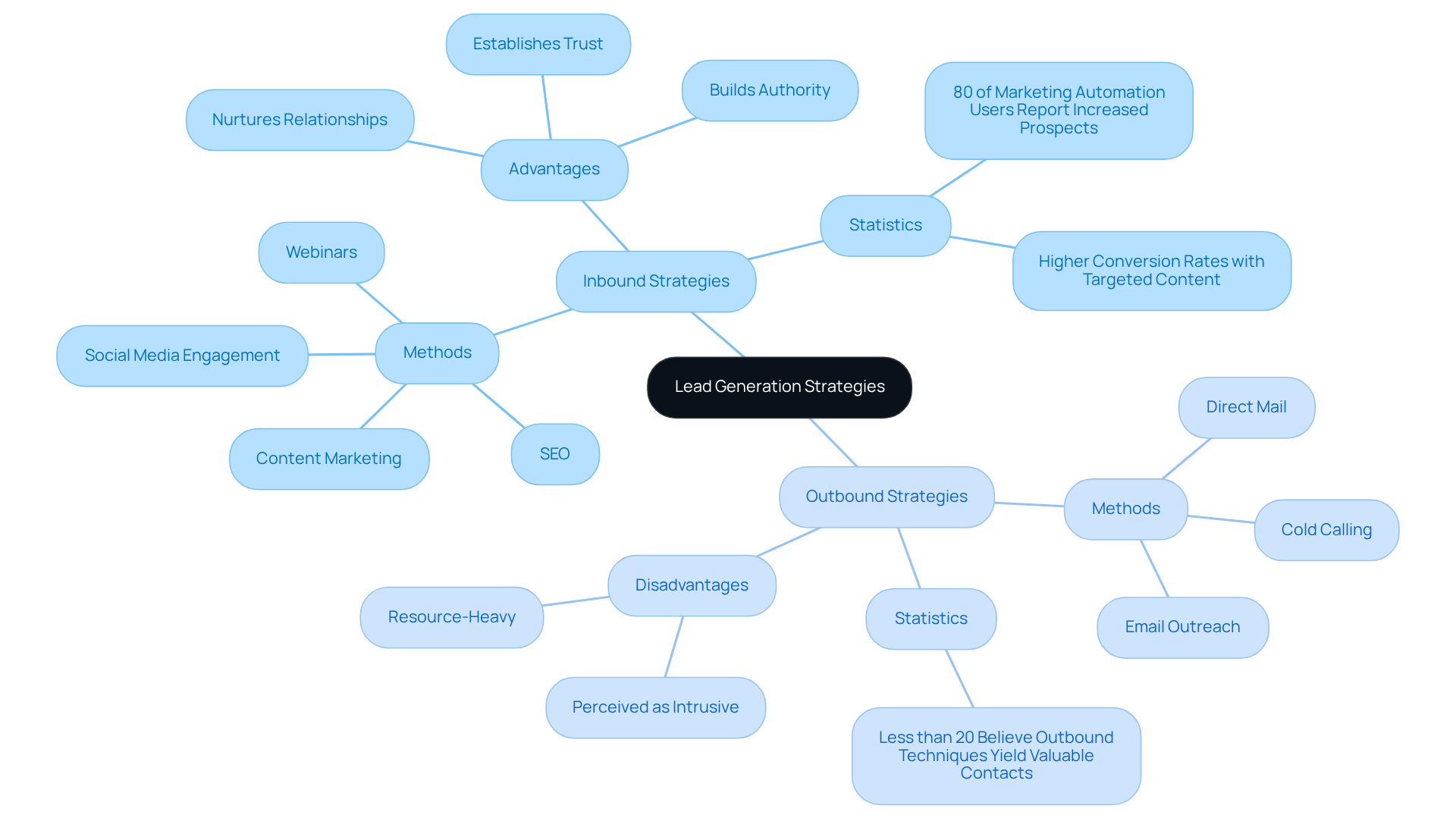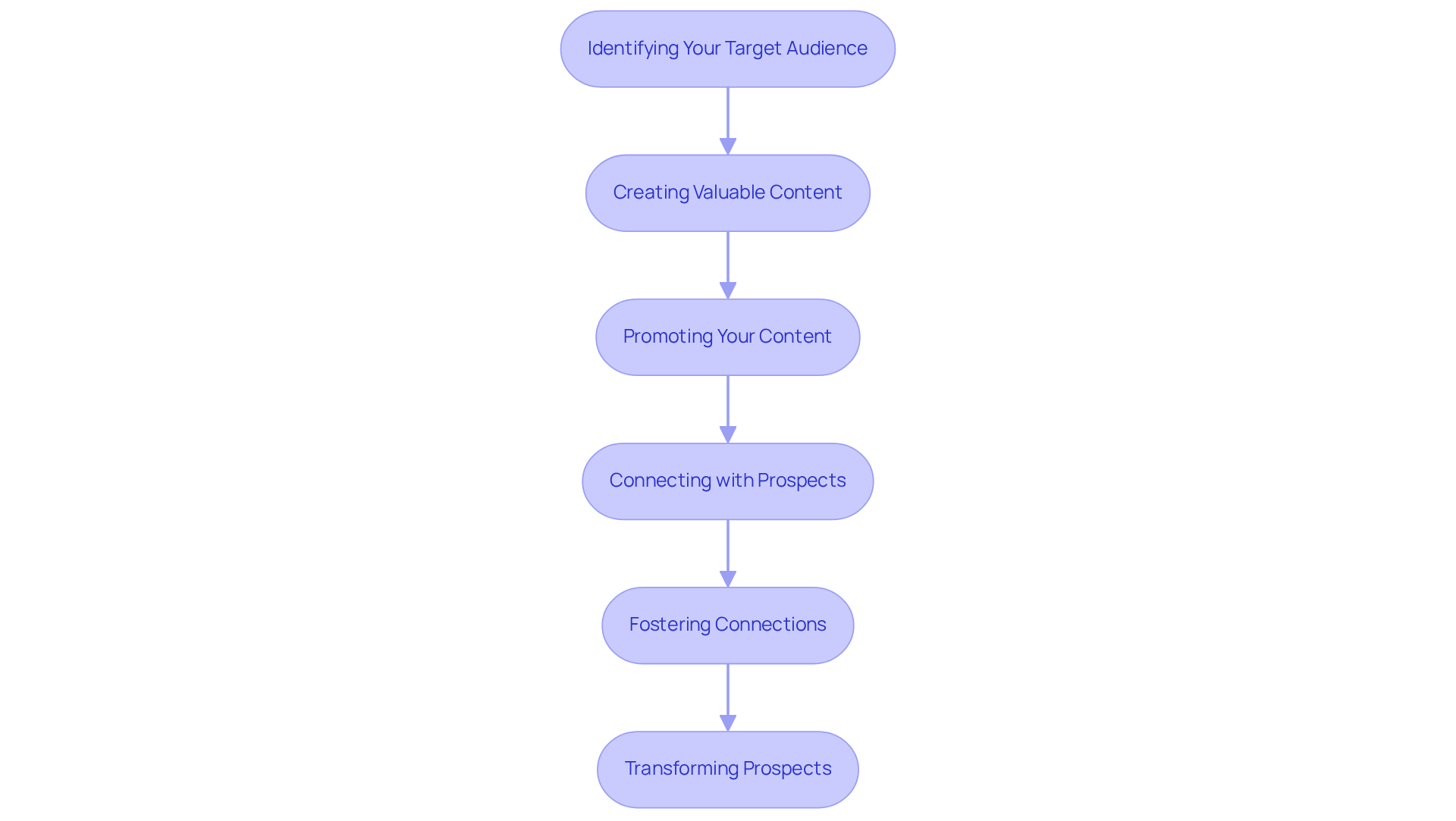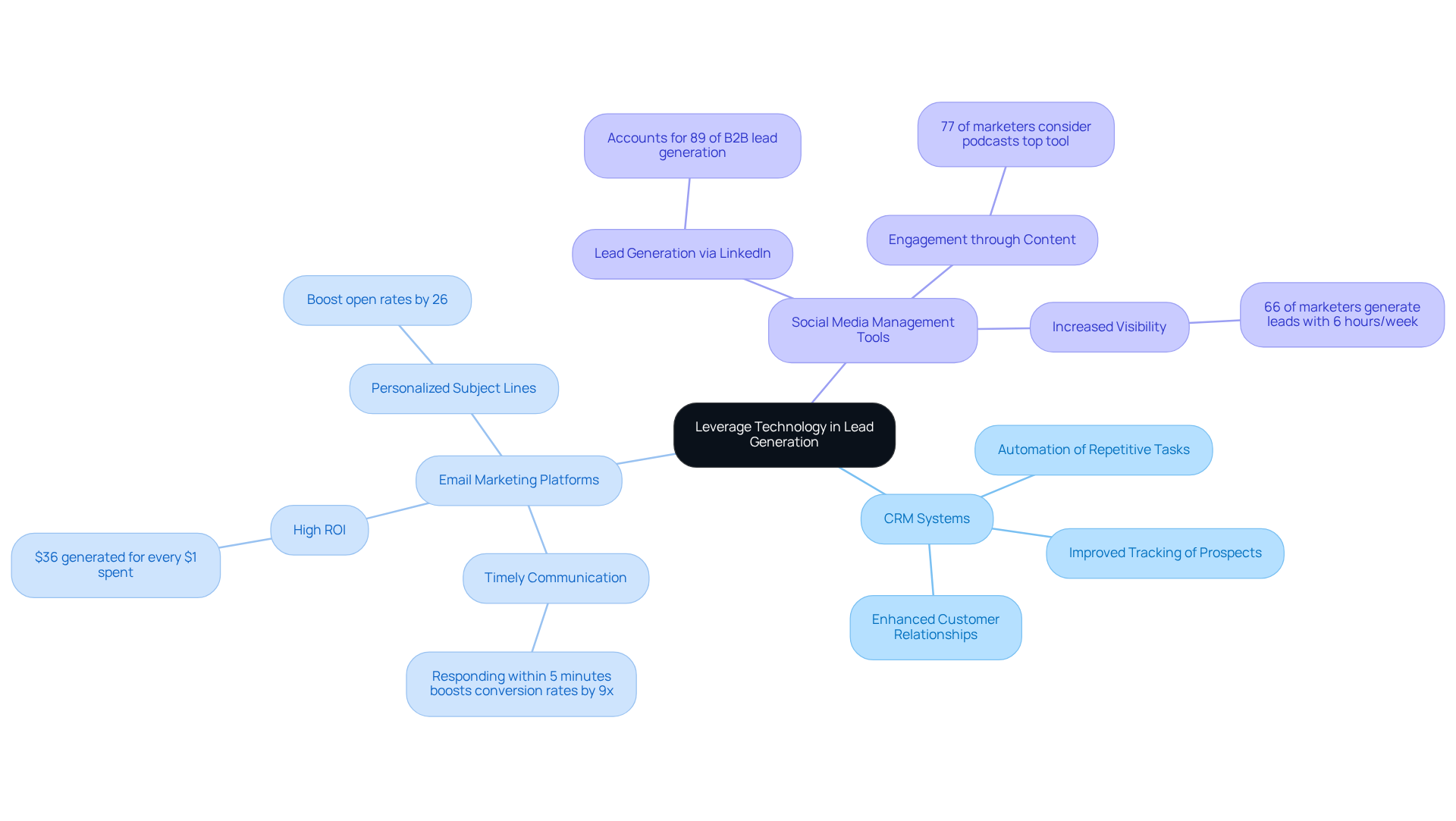Overview
This article explores the various types of lead generation strategies that are essential for small businesses. We understand that navigating these options can be overwhelming, so let’s break it down together. Specifically, we’ll distinguish between inbound and outbound methods, focusing on what truly matters for your growth.
Inbound strategies, which prioritize valuable content and meaningful engagement, are becoming increasingly favored. This shift is not just a trend; it’s backed by statistics showing that these methods attract more qualified prospects and yield higher conversion rates compared to traditional outbound techniques. Isn’t it reassuring to know that there are effective ways to connect with your audience?
By embracing inbound strategies, you can create a nurturing environment that resonates with potential customers. Remember, it’s about building relationships and providing value. As you consider your options, think about how these approaches align with your business goals. Together, we can achieve success by focusing on what works best for you.
Introduction
Lead generation is a vital cornerstone for the success of small businesses, and yet, many find themselves struggling to navigate its complexities in a competitive marketplace. We understand your challenges. By exploring the various types of lead generation—both inbound and outbound—you can gain invaluable insights that help transform potential prospects into loyal customers. However, it’s concerning to note that a staggering 80% of new prospects fail to convert. This raises an important question: how can small enterprises effectively harness lead generation strategies to attract and retain clients in such a challenging landscape? Together, we can find solutions that empower your business to thrive.
Define Lead Generation: Understanding Its Importance for Small Businesses
Lead acquisition is the vital process of identifying and attracting potential clients for your products or services. For small enterprises, this process is crucial for success. We understand that is essential as it directly impacts your sales and income. By creating opportunities, you can cultivate a stream of prospective clients, enhancing interactions and transforming them into loyal customers.
In today's competitive digital landscape, having a strong customer acquisition strategy is not just beneficial; it’s essential for your business's survival and growth. This strategy empowers you to reach your target audience, understand their needs, and tailor your offerings accordingly. Ultimately, this approach enhances sales and fosters customer loyalty.
Consider this: statistics reveal that 80% of new prospects do not convert to sales. This highlights the pressing need for improved nurturing strategies. Furthermore, 61% of marketing experts identify client acquisition as their primary challenge, indicating a widespread demand for effective solutions. By implementing [effective client acquisition strategies](https://blog.wayy.ai/10-benefits-of-lead-generation-outsourcing-for-small-businesses)—like content marketing—you can generate three times more prospects than traditional methods, making it an invaluable asset for your business expansion. For instance, businesses that publish 15 blog articles each month can attract approximately 1,200 new prospects, showcasing the significant impact of consistent content generation.
Industry specialists echo this sentiment, with 85% of B2B firms viewing customer acquisition as their top marketing objective. As you navigate the complexities of the market, understanding and applying effective customer acquisition strategies will be essential for boosting your sales and achieving sustainable revenue growth. Together, we can overcome these challenges and pave the way for your success.

Explore Types of Lead Generation: Inbound vs. Outbound Strategies
Lead acquisition can be categorized into two primary types of lead generation: inbound and outbound strategies. Inbound customer generation focuses on attracting potential clients through valuable content, social media engagement, and search engine optimization (SEO). This method draws in potential clients by addressing their needs and offering solutions, thereby establishing trust and authority. Effective methods such as content marketing, webinars, and social media campaigns not only engage prospects but also nurture relationships over time. Companies that prioritize inbound marketing often experience a substantial rise in qualified prospects, demonstrating its efficiency.
On the other hand, outbound prospecting is considered one of the types of lead generation, as it entails actively reaching out to potential clients using techniques like cold calling, email outreach, and direct mail. While can yield immediate results, they often require more resources and may be perceived as intrusive. It’s important to note that fewer than 20% of marketers believe that outbound techniques yield valuable contacts, suggesting an increasing inclination towards inbound approaches.
Current trends emphasize the growing significance of inbound prospect generation for small businesses. With 80% of marketing automation users indicating a rise in prospects, the transition towards inbound strategies is clear. Moreover, marketers achieve higher conversion rates when focusing on prospects according to their stage in the sales funnel, further highlighting the necessity for customized content.
To enhance their customer acquisition efforts, local entrepreneurs can utilize tools like Wayy.ai, which provides efficient client onboarding through features such as a one-click sales playbook and focused outreach. Additionally, Wayy.ai offers daily email insights that monitor essential metrics, including how many prospects were reached, who expressed interest, and the conversion rate. This enables companies to refine their strategies effectively.
By understanding the strengths and weaknesses of both approaches, modest enterprises can create a balanced strategy for attracting clients that aligns with their goals. Together, we can leverage the long-term benefits of inbound marketing while still considering the immediate impact of outbound efforts. Remember, we understand your challenges, and with the right strategies, success is within reach.

Analyze the Lead Generation Process: Steps to Attract and Convert Leads
The lead generation process for small businesses involves several essential steps:
- Identifying Your Target Audience: We understand that knowing your ideal customers is fundamental. By developing buyer personas, you can tailor your messaging and outreach strategies effectively to connect with those who truly need your services.
- Creating Valuable Content: It's important to produce content that addresses the specific needs and pain points of your audience. Consider creating blog posts, eBooks, webinars, and videos that provide insights and solutions, helping your audience feel understood and supported.
- Promoting Your Content: Utilize a multi-channel approach to distribute your content. Engage with social media, email marketing, and SEO to connect with a wider audience and draw in potential clients who are searching for the solutions you offer.
- Connecting with Prospects: Once prospects show interest, take the time to interact with them through tailored communication. Answer their questions and provide additional information to build trust and rapport, showing that you care about their needs.
- Fostering Connections: Implement nurturing strategies to maintain relationships with potential clients. Tailored email campaigns and thoughtful follow-ups can keep your brand top-of-mind until they are ready to purchase. For instance, a case study demonstrated that personalized email marketing significantly enhanced conversion rates by addressing potential customers' specific interests.
- Transforming Prospects: Finally, employ effective sales techniques to turn prospects into paying customers. This includes using compelling offers and addressing any objections they may have, ensuring they feel valued throughout the process.
By adhering to these steps, small enterprises can create a structured method for attracting clients using different types of lead generation that improves their likelihood of success. Using can enhance client acquisition through its one-click sales playbook and focused outreach, while daily email insights offer valuable metrics on prospect tracking, interest levels, and conversion rates, ultimately boosting overall sales performance. Together, we can achieve success in your client acquisition journey.

Leverage Technology in Lead Generation: Tools and Automation for Efficiency
In today's digital landscape, technology is vital for enhancing the various types of lead generation. Have you ever felt overwhelmed by the sheer number of tasks required to attract potential customers? Customer relationship management (CRM) systems, email marketing platforms, and social media management tools can significantly improve your ability to draw in and convert prospects. Automation tools, like Wayy.ai, are designed to simplify your outreach process by managing repetitive tasks. This allows your team to focus on nurturing relationships with potential customers, which is so important for your business's success.
These tools not only assist in tracking prospects and monitoring engagement but also provide essential performance metrics that guide your future strategies. By embracing technology, small enterprises like yours can enhance their prospect generation efforts, ensuring timely interaction with potential customers. Did you know that companies responding to inquiries within just five minutes can boost conversion rates by as much as nine times? This statistic underscores the importance of timely communication.
Moreover, a remarkable 77% of marketers report improved prospect conversions through automation, highlighting its effectiveness in streamlining processes and enhancing overall efficiency. As you and other small businesses adopt these technological advancements, you position yourselves to achieve greater success in your types of lead generation endeavors. Together, we can and thrive in this competitive environment.

Conclusion
Understanding the various types of lead generation is crucial for small businesses like yours, especially in today’s competitive market. Effective lead generation not only helps you identify and attract potential customers but also plays a pivotal role in enhancing your sales and fostering long-term relationships. By implementing a well-rounded strategy that incorporates both inbound and outbound techniques, you can create a sustainable pipeline of prospects that drives growth.
Throughout this article, we’ve discussed key insights that matter to you, including:
- The importance of defining your target audience
- Creating valuable content
- Leveraging technology to streamline your lead generation process
The distinction between inbound and outbound strategies highlights the need for a balanced approach. Nurturing relationships through valuable content can yield substantial long-term benefits, while direct outreach techniques can provide immediate results. Additionally, utilizing tools like Wayy.ai can significantly enhance your efficiency and effectiveness in acquiring leads.
Ultimately, your success hinges on your ability to adapt and implement effective lead generation strategies. Embracing technology and understanding the nuances of customer acquisition will empower you not only to attract but also to convert leads into loyal customers. It is essential for you as an entrepreneur to take proactive steps in refining your lead generation approaches, ensuring that you remain competitive and responsive to market demands. Together, we can achieve success in navigating these challenges.
Frequently Asked Questions
What is lead generation?
Lead generation is the process of identifying and attracting potential clients for your products or services, which is crucial for the success of small businesses.
Why is lead generation important for small businesses?
Lead generation is vital for small businesses as it directly impacts sales and income, helping to create opportunities that can turn prospects into loyal customers.
What role does a customer acquisition strategy play in lead generation?
A customer acquisition strategy is essential for reaching your target audience, understanding their needs, and tailoring offerings, which enhances sales and fosters customer loyalty.
What statistics highlight the challenges of lead generation?
Statistics show that 80% of new prospects do not convert to sales, and 61% of marketing experts consider client acquisition their primary challenge, indicating a need for improved nurturing strategies.
How can effective client acquisition strategies improve lead generation?
Implementing effective client acquisition strategies, such as content marketing, can generate three times more prospects than traditional methods, significantly aiding business expansion.
What is the impact of consistent content generation on lead generation?
Businesses that publish approximately 15 blog articles each month can attract around 1,200 new prospects, demonstrating the significant impact of consistent content generation.
What do industry specialists say about customer acquisition?
85% of B2B firms view customer acquisition as their top marketing objective, underscoring its importance in navigating market complexities and boosting sales.




